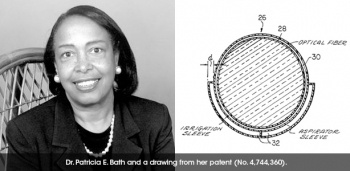Feb122014
Posted at 1:46 PM
Editor's note: This has been cross-posted from Inventor's Eye, the U.S. Patent and Trademark Office's Publication for the Independent Inventor Community
February and March are Black History Month and Women’s History Month, respectively. Inventors Eye takes a look at past and present to salute the many Black women inventors who have contributed to the growth of innovation in America.
Black women throughout American history have impacted and contributed to our nation’s culture of innovation. Patents offer a unique lens through which to view history. By tracing the technologies patents protect—or once protected—as well as the inventors listed on those patents, an image of the past emerges. The United States Patent and Trademark Office has granted patents for more than 200 years. That’s a lot of history, and it contains many stories of successful black women who have changed the technological face of America. Today, black women continue to ignite the spark of genius and make key and meaningful contributions to America’s inventive process.
The trove of historical information locked in patents can be a challenge to extract, as patents do not record extensive personal details about inventors such as race. Adding to the difficulty is the common practice of early inventors to use initials as a way to conceal their identity or gender. There is ongoing debate about the first black woman inventor, but modern research tools have made it less difficult to assemble the pieces of the puzzle. Though we may never be able to tell the full story of black women inventors, the findings reveal that they have consistently conceived innovative ideas and aggressively filed patent applications throughout history.
Martha Jones of Amelia County, Va., might have become the first black woman to receive a United States patent. Her application for an “Improvement to the Corn Husker, Sheller” was granted U.S. patent No. 77,494 in 1868. Jones claimed her invention could husk, shell, cut up, and separate husks from corn in one operation, representing a significant step forward in the automation of agricultural processes. Five years later in 1873, Mary Jones De Leon of Baltimore was granted U.S. patent No. 140,253 for a novel cooking apparatus. De Leon’s invention consisted of the construction and arrangement of a device for heating food by dry heat and steam. The design of the apparatus shows that it was an early precursor to the steam tables now found often at food buffets.
Other documented 19th century black women inventors include Judy W. Reed and Sarah Goode. Reed, from Washington, D.C., was granted a patent in 1884 for a dough kneader and roller (U.S. patent No. 305,474) and Goode, from Chicago, was granted a patent in 1885 for a folding cabinet chair (U.S. patent No. 322,177).
While it is unknown if any black woman received a patent prior to the Civil War, there is irony in the fact that black women obtained patents long before passage of the 19th Amendment granting women the right to vote or the advances in civil rights during the 1950s and ‘60s.
Starting in the 20th century it became far easier to determine the identity of inventors thanks to improvements in archiving information. Modern black women continue to make significant innovations in a variety of technological fields. One such inventor is Dr. Patricia E. Bath, who invented a widely used method and apparatus of removing cataracts (U.S. patent No. 4,744,360). This invention uses lasers to remove cataracts from the eye in a less-invasive way and has helped restore or improve vision to millions of patients worldwide, making it one of the most important developments in the field of ophthalmology.
Sandra Johnson, the first black woman to earn a doctorate in electrical engineering in the United States, has made many contributions to computer architecture during her career with IBM. She was part of the team that designed the prototype for IBM’s “Deep Blue”—the chess playing computer that defeated Garry Kasparov. Johnson is listed on over 40 U.S. patents.
Although compiling a complete list of black women inventors may be impossible, their influence is felt by us every day through their inventions that have changed how we work and play. As we observe both Black History Month in February and Woman’s History Month in March, let’s take time to honor these individuals who have contributed so much to our way of life and to the progress of science and useful arts.


